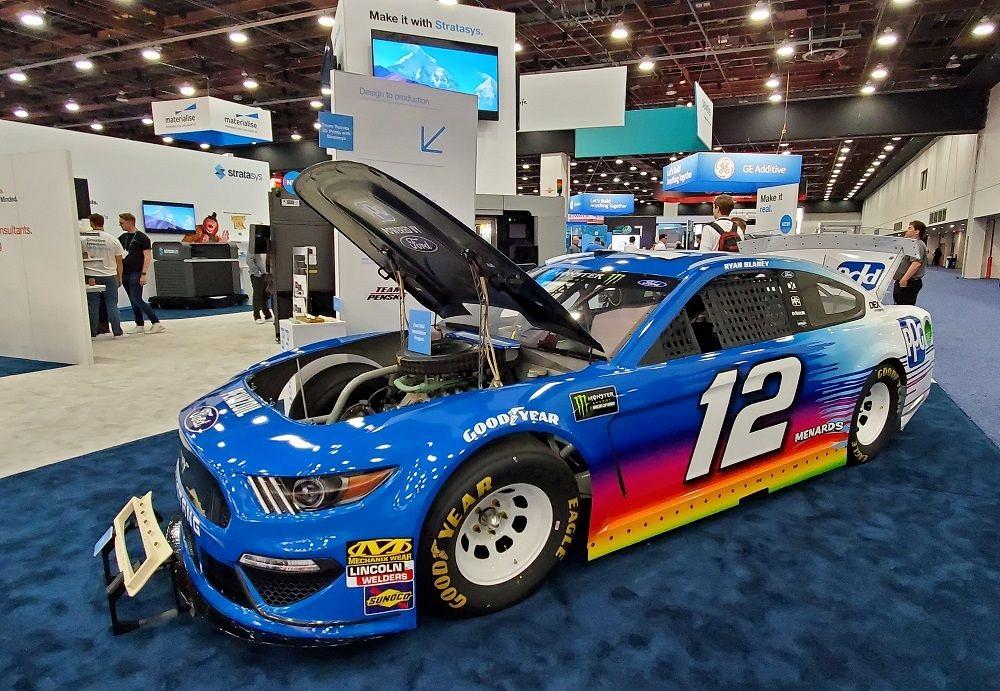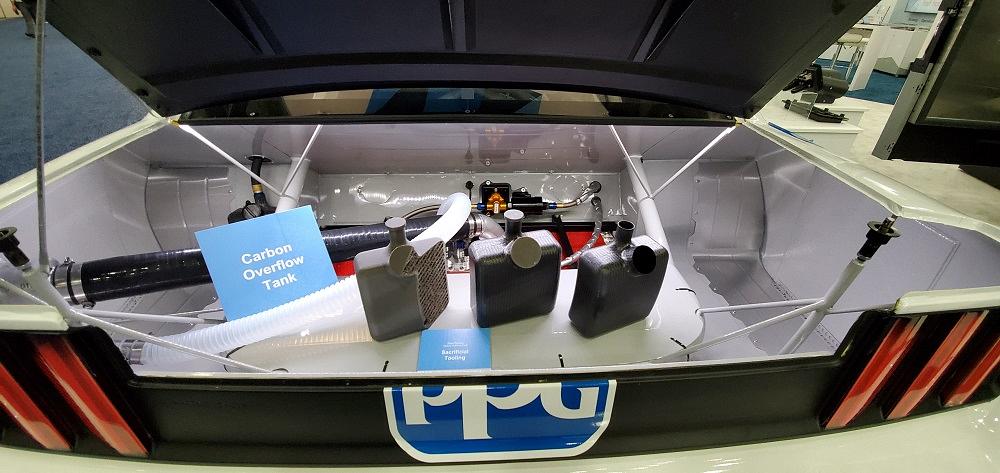Sr. Digital Editor
- FMA
- The Fabricator
- FABTECH
- Canadian Metalworking
Our Publications
Categories
- Additive Manufacturing
- Aluminum Welding
- Arc Welding
- Assembly and Joining
- Automation and Robotics
- Bending and Forming
- Consumables
- Cutting and Weld Prep
- Electric Vehicles
- En Español
- Finishing
- Hydroforming
- Laser Cutting
- Laser Welding
- Machining
- Manufacturing Software
- Materials Handling
- Metals/Materials
- Oxyfuel Cutting
- Plasma Cutting
- Power Tools
- Punching and Other Holemaking
- Roll Forming
- Safety
- Sawing
- Shearing
- Shop Management
- Testing and Measuring
- Tube and Pipe Fabrication
- Tube and Pipe Production
- Waterjet Cutting
Industry Directory
Webcasts
Podcasts
FAB 40
Advertise
Subscribe
Account Login
Search
Stratasys increases its 3D-printing footprint across auto racing
3D printer manufacturer announces partnerships with Don Schumacher Racing and Arrow SPM at Rapid + TCT
- By Gareth Sleger
- May 25, 2019

Stratasys displayed Ryan Blaney's No. 12 car from Team Penske, which featured several 3D-printed parts, at the Rapid + TCT show May 21-23, 2019, in Detroit. Penske has been a partner with Stratasys since 2017.
If you tune into the Indy 500 over this Memorial Day weekend, you may notice a common theme as the cars zip around the Indianapolis Motor Speedway. Of the 33 IndyCars on the iconic track, 13 will feature a sponsorship logo from 3D printer and production systems manufacturer Stratasys.
Last year, only two cars at the premier IndyCar Series event donned the Stratasys logo.
"Going from a couple of cars to 13 in a year, I think that's boding quite well for where we want to go in the near future,” said Scott Sevcik, Stratasys VP and Head of Manufacturing Solutions.
The Eden Prairie, Minn.-based company has long provided additive manufacturing solutions for auto racing teams across different circuits, but it recently further increased its massive footprint in the sport. At Rapid + TCT 2019 this past week in Detroit, Stratasys announced partnerships with Arrow Schmidt Peterson Motorsports of IndyCar Series and Don Schumacher Racing of National Hot Rod Association (NHRA).
“We're feeling pretty good about what we're able to do for these teams,” Sevcik told me while visiting the Stratasys booth at Rapid. “They're appreciative of the technology we bring to the sport. It's another big step towards recognizing that additive can be high performance.”
Arrow SPM and Don Schumacher Racing join the likes of Team Penske, McLaren Racing, and Joe Gibbs Racing to employ Stratasys’ deep background in auto racing-focused AM offerings.
“We’re doing things for them that no one else can do,” Sevcik said. “And that's what we're seeing on the track.”
Both Don Schumacher Racing, which has become the winningest team in NHRA, and Arrow SPM will be using Stratasys’ Fused Deposition Modeling (FDM) technology for prototyping acceleration and new component design on the Fortus 450mc 3D Printer, which prints carbon fiber-reinforced FDM Nylon 12, and the F370 3D Printer.
The Don Schumacher Motorsports fabrication facility, the production division of Don Schumacher Racing, has already applied the technology to produce chassis and weldment fixturing, prototyping, finalized proof-of-concept design, and usable lightweight components for its Top Fuel, Funny Car, and Factory Stock teams.
“The jumped straight to putting [3D-printed] parts in the engine,” Sevick said of Schumacher. “They are going to leverage all of the AM applications, but they’ve already it all the way home.”

Team Penske 3D-printed overflow tanks for some of its race cars using Stratasys additive manufacturing technology.
Arrow SPM will feature in this weekend’s Indy 500 with No. 7 driver Marcus Ericsson, whose pit crew won Friday’s Indy 500 Pit Stop Challenge.
"In a lot of cases it's enabling them to understand what's possible at the technology and then they just run away with it when they figure out the things that they need," Sevcik said.
While Joe Gibbs Racing became a pioneer in terms of using AM for prototyping and testing more than 15 years ago, Team Penske’s success on the track last season with extensive AM tooling and 3D-printed parts on its cars made the auto racing scene take notice.
“We had a real groundswell of interest,” Sevcik said. "What Penske did last year gave a lot of teams the confidence to take the next step.”
Penske and Stratasys developed a partnership in 2017, but the collaboration went to the next level last year with improved AM design and FDM parts for its NASCAR, IndyCar, and IMSA vehicles.
Using carbon-fiber composite materials like Nylon 12 for better strength, fatigue resistance, and light weighting, Penske produced innovative 3D-printed components such as a fuel line hose handle, overflow tank, mirror housing frame, as well as other jigs, fixtures, and end-use race-day parts.
“With Penske and some of our other partners," Sevcik said, "we've gotten much, much deeper in terms of working with them on applications, looking at challenges, and figuring out the solution."
Sevcik added that these AM solutions used to improve race cars will soon translate into the auto industry and its original equipment manufacturers (OEM). As race teams find out what 3D printing technology makes production more efficient and cars faster, OEMs will apply that to factory production.
“Relationships run very, very deep between race teams and the different OEMs,” he said. “Those technologies that get proven out on the track or in the shop are usually destined for the factories. Even if it’s not about making the car faster, if you can take time off the assembly process, that’s hugely valuable.”
Couldn't make it to the Rapid + TCT in Detroit? Check out more of our show coverage on our YouTube channel.
About the Author

About the Publication
- Podcasting
- Podcast:
- The Fabricator Podcast
- Published:
- 04/16/2024
- Running Time:
- 63:29
In this episode of The Fabricator Podcast, Caleb Chamberlain, co-founder and CEO of OSH Cut, discusses his company’s...
- Trending Articles
- Industry Events
16th Annual Safety Conference
- April 30 - May 1, 2024
- Elgin,
Pipe and Tube Conference
- May 21 - 22, 2024
- Omaha, NE
World-Class Roll Forming Workshop
- June 5 - 6, 2024
- Louisville, KY
Advanced Laser Application Workshop
- June 25 - 27, 2024
- Novi, MI


























